
Top 13 Palm Plants Varieties
Are you hoping to give your home a touch of the tropics? When did you relax on a beach under a palm tree? If you had a chance to visit the Maldives or another tropical island, you must have loved every minute of it. Unfortunately, not everyone can relax under the terrific palm trees and relaxed atmosphere.
Not to worry! You may make them yourself with the help of our indoor palm plants!

Additionally, you get to breathe in clean air. That's right, grow these phenomenal air purifiers to cleanse your respiratory system of harmful urban gases. The indoor palm tree is one of the most striking indoor plants.

Indoor Palm Plant Maintenance Advice
Like many other houseplants from the tropics, indoor palm plants require similar maintenance.
Since they typically grow slowly, palms only require minor trimming to remove their dead and damaged fronds. A high-quality palm fertiliser will be necessary to support their lush growth.
Here are thirteen types of palms that are the simplest to cultivate indoors and will give your home a light, tropical air.
1. Areca Palm
Scientific Name: Dypsis lutescens
Their close clustering, golden stems, and delicate fronds resemble bamboo. The Areca palm is also known as the butterfly palm, golden cane palm, and bamboo palm. It develops enormous, curving, fluffy green fronds.
Care:
Bright sunlight, high humidity, and moderate watering are all favourable for the growth of these palm palms. Ample sunshine is essential for growth, but don't place the leaves in the sun's direct path to prevent scorching them.
2. Chinese Fan Palm
Scientific Name: Livistona chinensis
Livistona chinensis differs from other palms with the more traditional feathery fronds with star-shaped leaves. Although it grows slowly, the full height of this type of palm can be up to 15 feet. In light of this, if you intend to cultivate the palm inside, it is worthwhile to look for the subglobosa dwarf cultivar.
Care:
If you are considering a long-term indoor arrangement for these plants, which mature at a height of 15 feet, it is best to use the dwarf variety. Depending on how damp the soil is, spray them once or twice a week.

3. Fishtail Palm
Scientific Name: Caryota mitis
The name "Fishtail Palm" refers to the shape of the chopped leaves, similar to fishtails. These are harder to keep alive, especially indoors. The leaves on these plants have lengthy stalks and branch at various nodes. They are simple to cultivate.
Care:
They need constant access to water and a lot of bright light. Epsom salt treatments help to replenish magnesium deficiency when leaves become spotted. It probably only requires more sunlight.
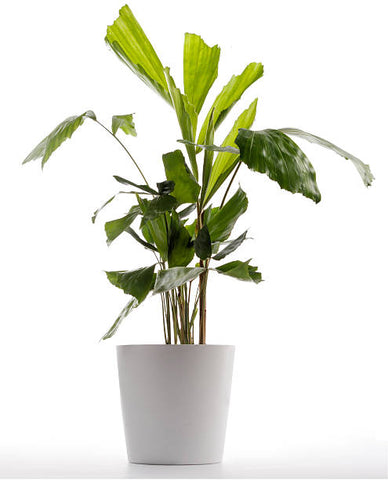
4. Majesty Palm
Scientific Name: Ravenea rivularis
The majesty palm, which may be grown indoors, has two advantages:
It grows slowly and is tolerant to shade. However, one should be mindful of this palm's two shortcomings: It will eventually overtake an indoor space because it requires regular humidity and wetness.
You can look forward to establishing a majestic stand of dark green fronds that will lend life to an empty corner of your home if you can keep your majesty palm in a moderately damp environment, like the kitchen or bathroom.
Care:
With this plant, even the most seasoned gardeners will struggle. It requires the perfect ratio of water, light, and fertiliser. A sickly plant has bleached leaves needs more filtered light.
The bottom leaves fall off when there is not enough water. The monthly Epsom salt treatment's magnesium content stops the leaves from turning yellow. A Majesty Palm needs humidity to repel insects, and misting gives that. A longer, slimmer plant is the result of too much fertiliser.
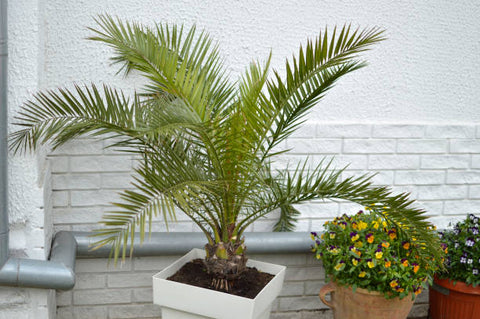
5. Cascade Palm
Scientific Name: Chamaedorea cataractarum
These palm trees, which have long, slender stems and green fronds, may add beauty to your interior decor. Cat palms or cataract palms are other names for them. It has thick leaves and a cluster of stems similar to the Ivory Cane Palm. They are pet-friendly and have a modest rate of growth.
Care:
To avoid scorching the leaves of a Cascade Palm cultivated indoors in a container, keep it in a bright area but out of direct sunlight.

6. Lipstick Palm
Scientific Name: Cyrtostachys Renda
Do you want some colour? What about the colourful tree that matches the shade of your lipstick?
How adaptable these plants are is mind-blowing. They feature vivid crimson stems that gradually taper into fronds of green.
Care:
Check to see if the water level is only moistening rather than clogging. Root rots and fungal diseases are more likely to occur in soggy soil. Replanting these plants every few years into a bigger pot is necessary so that their roots can spread out because they might become root-bound.

7. Ruffled palms
Scientific Name: Licuala grandis
Ruffled palms will become your favourite if fan palms are your favourite! They feature a wonderfully fan-like frond with pleats. They appear fantastic when grown inside. Additionally, these pleats give your interiors an excellent texture.
Care:
These plants do well in cool climates and the shade. Watering them can be cut back since they like dim illumination. Take extra precaution since these ruffled fan plan plants' pleated edges might occasionally resemble spines.
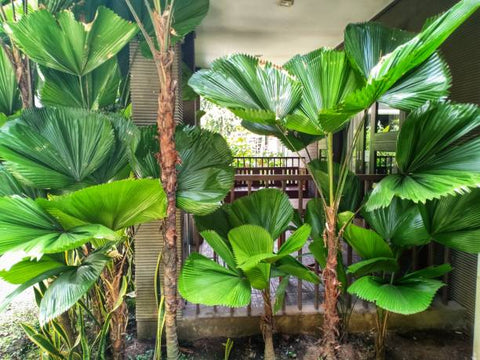
8. Parlour palm
Scientific Name: Chamaedorea elegans
The parlour palm is one of the simplest palms to grow indoors. It develops in room temperatures and average indoor light, including artificial light. It doesn't need trimming outside the occasional tidying of dead limbs.
Care:
It doesn't mind cold temperatures like certain plants, such as the Majestic Palm, and thrives in low-light settings like office shelves.
It is preferable to let them dry out because they are prone to overwatering. Watch for limp fronds, which are a sign that it needs watering. If the leaf tips start to turn brown, raise the humidity level in the space. Surplus humidity is ideal for parlour palm growth.
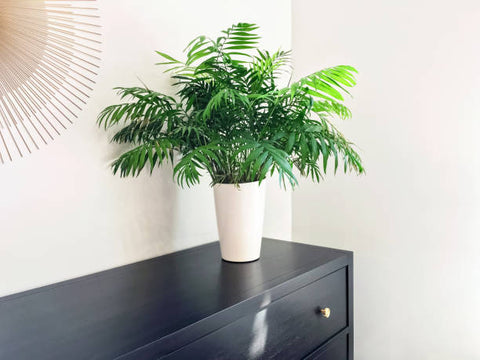
9. Ponytail Palm
Scientific Name: Beaucarnea recurvate
The ponytail palm, with its short, robust stem and beautifully arching leaves, renders the identification of indoor palm plants effortless.
In addition to being decorative, the plant's enlarged trunk base serves as water storage, making it drought resilient.
Care:
These plants can tolerate indirect light. Provide a sunny spot for your ponytail palm for the best plant health. They do well in sandy soil. Water them once a month in the winter and once every two weeks in the summer.
Transplant the plant if you want it to grow larger so the roots can spread out. Keep it in a shallow container if you need a little quantity. Ponytail palms are excellent for novices.
10. Sago Palm
Scientific Name: Cycas revoluta
If the sago palm is your first encounter with indoor palm plants, you're in for a treat. A short, unkempt trunk that resembles a pineapple is the source of stiff fronds that develop in an erect habit.
These indoor palm plants are simple to grow and make excellent ornaments. The firm, spine-like fronds give your interiors a wonderful texture and tropical freshness.
Care:
They flourish in direct, bright sunlight and grow slowly. Sago's palms only generate one green frond from April to autumn.
As they continue to gather nutrients for the plant, leave the yellowing leaves alone. You can remove the fronds as they become brown.
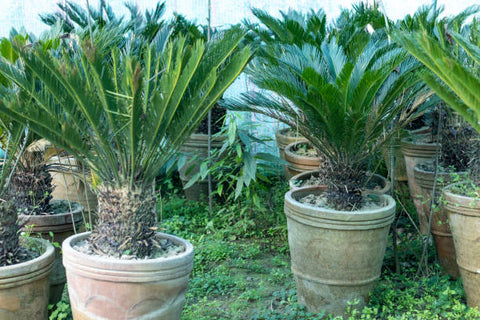
11. Bamboo Palm
Scientific Name: Chamaedorea seifrizii
You should pass on this plant if you ought to be forgetful and frequently forget to water.
They are tropical plants that require high levels of humidity to flourish. They look fantastic as a room divider or decorative feature in your courtyard.
Care:
They don't require bright light to thrive, unlike other palms.
Avoid direct sunlight since it will burn the fronds. In a home with a typical humidity level, your bamboo palm will flourish.

12. Yucca Palm
Scientific Name: Yucca elephantipes
Identification of indoor palm plants is crucial when it comes to yucca palms. The Spanish bayonet, yucca aloifolia, is an outdoor plant with razor-sharp leaves. Although the leaves of the spineless yucca palm, Yucca elephantipes, have a sharp tip, it is doubtful that this plant will bleed like its spiny cousin. On the yucca palm, tough, strappy green leaves sprout from a charming trunk.
Care:
Flourish in dry, well-lit surroundings. Thin growth results from insufficient sunshine, whereas overly bright sunlight damages the leaves. These arid-climate palms favour loose soil with good drainage.
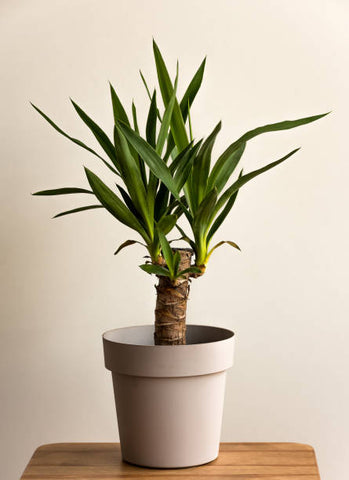
13. Red Feather Palm
Scientific Name: Chambeyronia macrocarpa
These plants' ruby fronds will astound you! The fronds' ridiculously gorgeous appearance when tinted crimson. When they first grow, they might develop beautiful flaming red fronds that eventually turn into green leaves. You will already have a new frond sprouting when one matures.
Care:
They are ideally suited to warm, humid, and low illumination. This plant needs frequent watering because it prefers humidity and can only tolerate short periods of drought. Up to twice a year, fertilisation may also be necessary.
Conclusion
I hope you are not any more perplexed after reading about some of our favourite palms for your indoor environment! Many palm trees may flourish indoors, so make sure to choose the one ideal for the location where you intend to put it so it has enough room to expand.

Consider the Indoor Palm plant more as an investment than anything else, although they are an expensive option and can survive up to 10 years. And there you have it! A few antiquities and wooden furniture. Pick your favourite palm from one of our 13 indoor palm plant collections to bring fresh air into your house and life.












Leave a comment